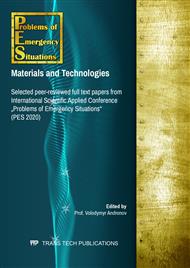[1]
N.V. Gnenny, O.N. Gnenny, Determination of the economic efficiency of a new type of passenger carriage, Bulletin of Dnipropetrovsk National University of Railway Transport named after Academician V. Lazaryan. 14 (2007) 255-260 [in Russian].
DOI: 10.15407/mining12.04.028
Google Scholar
[2]
Yu.S. Barabash, T.Yu. Charkina, Basic models of reforming out-of-town transport in Europe, Problems of the transport complex Ukraine, The Bulletin of Transport Economics and Industry. 45 (2014) 211-215 [in Russian].
Google Scholar
[3]
G. Welty, Railway Age, 8 (1997) 43-45.
Google Scholar
[4]
A.V. Petrov, M.S. Doriomedov, S.Yu. Skripachev, Foreign experience in the development of production of products using recycled polymer composite materials, Transactions of VIAM: electronic scientific journal. 12 (2015) 12 [in Russian].
DOI: 10.18577/2307-6046-2015-0-12-12-12
Google Scholar
[5]
M.S. Doriomedov, M.I. Daskovsky, S.Yu. Skripachev, E.A. Shein, Polymeric composite materials in railway transport of Russia (review), Scientific and Technical On-line Journal Trudy VIAM,. 7 (43) (2016) [in Russian].
Google Scholar
[6]
V.V. Makhan, B. Zenkevich-Galai, I. Welz, E.V. Ovchinnikova and A.P. Lavrov, Fire safety of passenger cars, Vestnik of the Railway Research Institute. 6 (2005) 2 [in Russian].
Google Scholar
[7]
N.M. Yaitskova, Research of vibroacoustic characteristics of passenger cars of various type, Vestnik rostovskogo gosudarstvennogo universiteta putej soobshcheniya. 2 (54) (2014) 33-37 [in Russian].
Google Scholar
[8]
V.A. Andronov, Yu.M. Danchenko, A.V. Skripinets, O.M Bukhman, Efficiency of utilization of vibration-absorbing polymer coating for reducing local vibration, Naukovyi Visnyk Natsionalnoho Hirnychogo Universytetu. 6 (2014) 85-91 [in Russian].
Google Scholar
[9]
V.B. Uzdensky, Refractory polymeric materials (compositions and composite concentrates), The journal Plastics,. 2 (2003).
Google Scholar
[10]
Al. Berlin, Combustion of polymers and materials with reduced flammability, Soros journal review. 9 (1996) 57-63.
Google Scholar
[11]
Mastika VML-25,, TU 2068474-296-92 [in Russian].
Google Scholar
[12]
Mastika VPM-1" ("Adem,), TU 2316-412-02068474-2004 [in Russian].
Google Scholar
[13]
I.I. Pestryakov, E.I. Gumerova, A.N Kupchin, Evaluation of the effectiveness of vibration damping material Teroson WT 129,, Construction of Unique Buildings and Structures. 5 (44) (2016) 46-57.
Google Scholar
[14]
N.V. Saienko, D.V. Demidov, R.A. Bikov, B.N. Younis, Effect of mineral fillers on the wetting of water-based polymer dispersions, IOP Conference Series: Materials Science and Engineering. 708 (1) (2019) 012103.
DOI: 10.1088/1757-899x/708/1/012103
Google Scholar
[15]
Mastika Antivibrit-M,, TU 6-05-211-1060-89 [in Russian].
Google Scholar
[16]
Ru-Jong Jeng, Shi-Min Shau, Jiang-Jen Lin, Wen-Chiung Su, Yie-Shun Chiu, Flame retardant epoxy polymers based on all phosphorus-containing components, European Polymer Journal. 38 (2002) 683-693.
DOI: 10.1016/s0014-3057(01)00246-4
Google Scholar
[17]
Tian, Xiu Juan, Thermal Stabilities and the Thermal Degradation Kinetics Study of the Flame Retardant Epoxy Resins, Advanced Materials Research.1053 (2014) 263–267.
DOI: 10.4028/www.scientific.net/amr.1053.263
Google Scholar
[18]
R. Oliwa, M. Heneczkowski, M. Oleksy, H. Galina, Epoxy composites of reduced flammability, Composites Part B: Engineering. 95 (2016) 1-8.
DOI: 10.1016/j.compositesb.2016.03.074
Google Scholar
[19]
N. Saienko, D. Demidov, Y. Popov, R. Bikov, V. Butskyi, Rheological properties of aquaeous dispersion of styrene acrylate copolymer incorporating hollow microspheres and AEROSIL®, Matec Web of Conferences, EDP Sciences. (230) (2018) 03017.
DOI: 10.1051/matecconf/201823003017
Google Scholar
[20]
E. Barabash, Y. Popov and Yu. Danchenko, Influence of intermolecular interactions of epoxy binder components on rheological properties and wetting ability, IOP Conference Series: Materials Science and Engineering. 708 (1) (2019).
DOI: 10.1088/1757-899x/708/1/012078
Google Scholar
[21]
Yu.M. Danchenko, A.V. Skripinets, A.V. Kabus, Study of technological and physico-chemical laws for the manufacture of vibration-absorbing products based on epoxyurethane polymer compositions, East European Journal of Advanced Technology. 75(2015) 4-8 [in Russian].
Google Scholar
[22]
M.I. Shut and A.V. Kaspersky, Method of relaxation spectrometer in the course of foreign physics, Kiev, 1990 [in Russian].
Google Scholar
[23]
J. Perez, The study of polymer materials by mechanical spectrometry, Polymer Science. 40 (1) (1988) 102-135.
Google Scholar
[24]
A. Nashif, D. Jones and J. Henderson.Vibration damping, Moscow, (1988).
Google Scholar
[25]
Z.H. Guangsu, C.X. Xianru, Advances in Sound Absorption Polymers, Progress In Chemistry. 3 (2004).
Google Scholar
[26]
A.I. Berezovsky, I.G. Maladyka, N.V. Saienko, R.A. Bykov, Evaluation of the thermal oxidative degradation and combustibility of reactive oligomers, Fire Safety: theory and practice. 7 (2011) 16-20 [in Russian].
Google Scholar
[27]
N.R. Zamani, A. Jumahat, R. Bahsan, Dynamic Mechanical Analysis of Nanosilica Filled Epoxy Nanocomposites, Applied Mechanics and Materials. 699 (2014) 239–244.
DOI: 10.4028/www.scientific.net/amm.699.239
Google Scholar
[28]
A. Berezovsky, I. Maladyka, Yu. Popov and N. Saeinko, Comparative analysis of combustion products components and their toxic property of both epoxy and epoxyurthane polymeric vibration-absorptive fire retardants, Fire Safety. 20 (2012) 27-31 [in Russian].
Google Scholar
[29]
E.V. Tretyakova, N.G. Selivanenko and L.M. Shafran, Toxicokinetics of carbon monoxide in polymer combustion products, Hygiene of populated places. 44 (2004) 193-199 [in Russian].
Google Scholar


